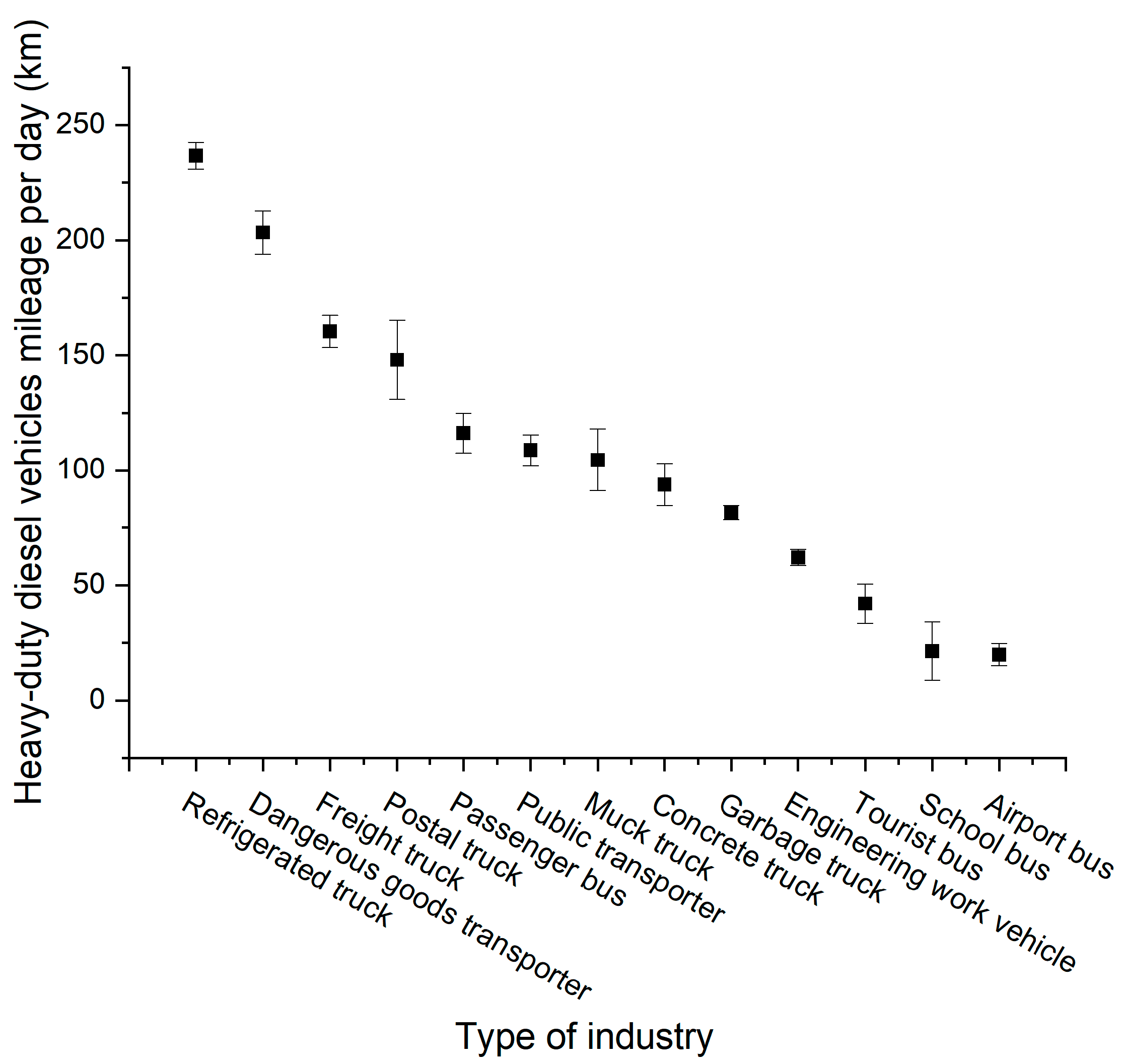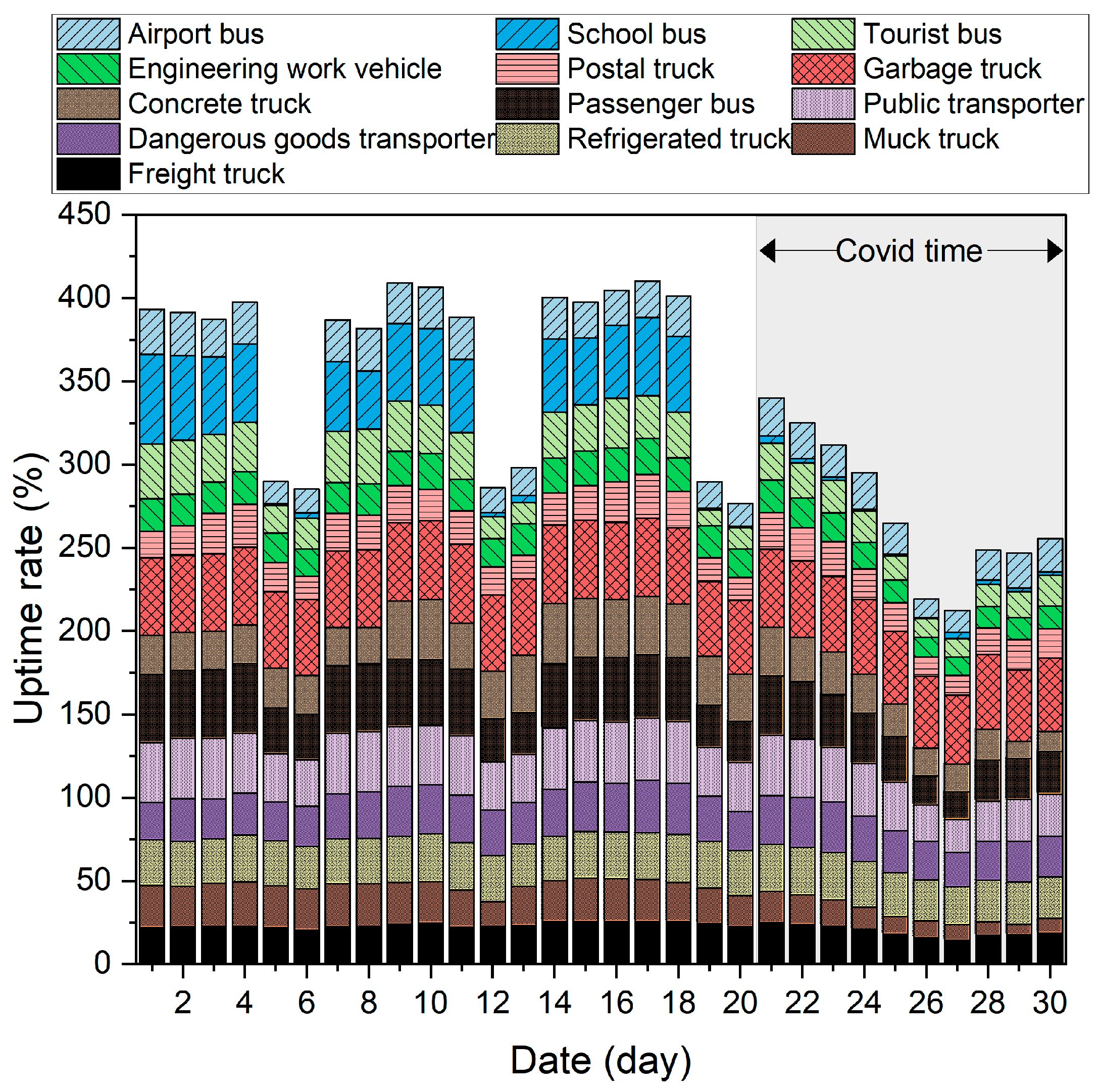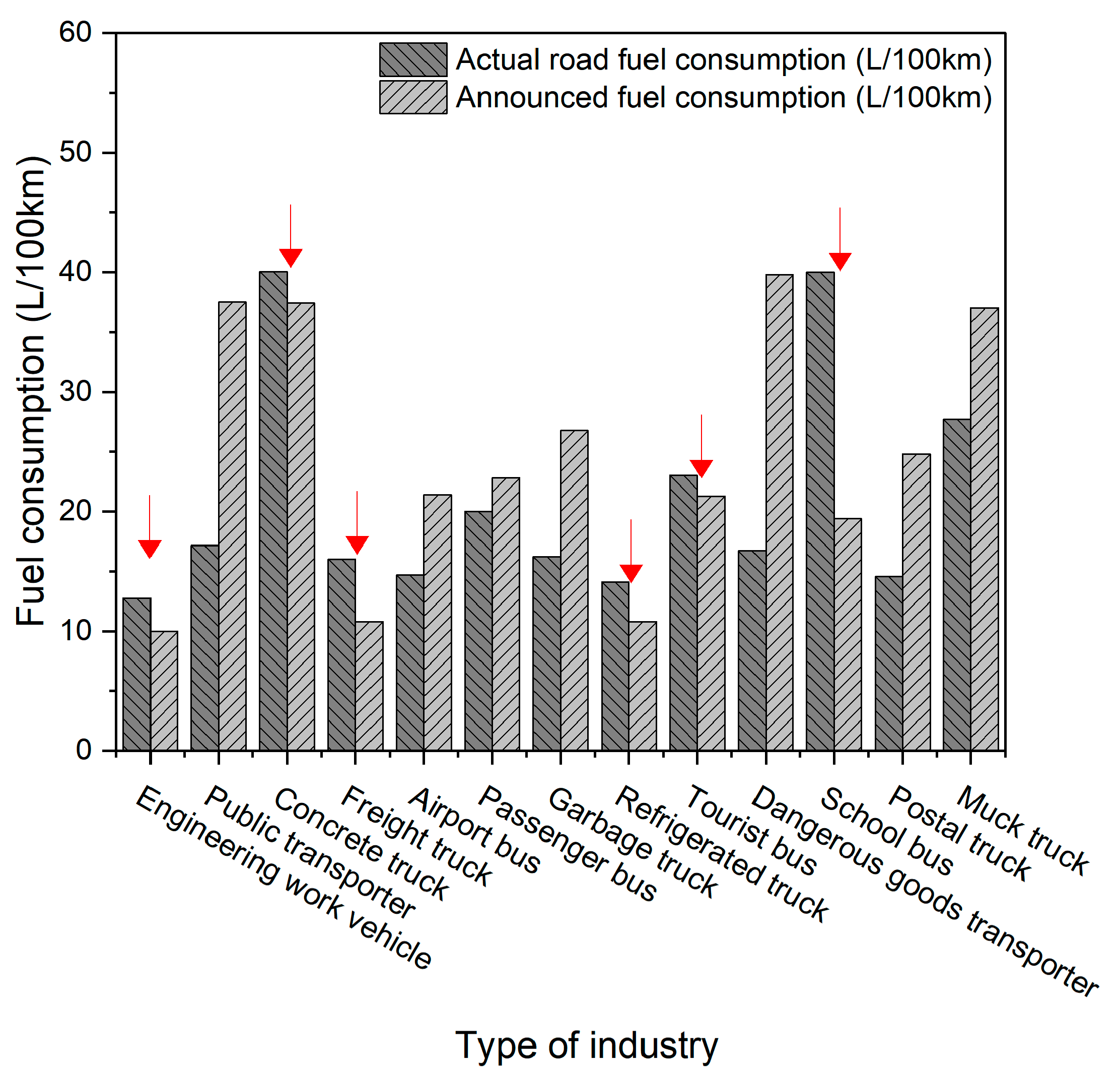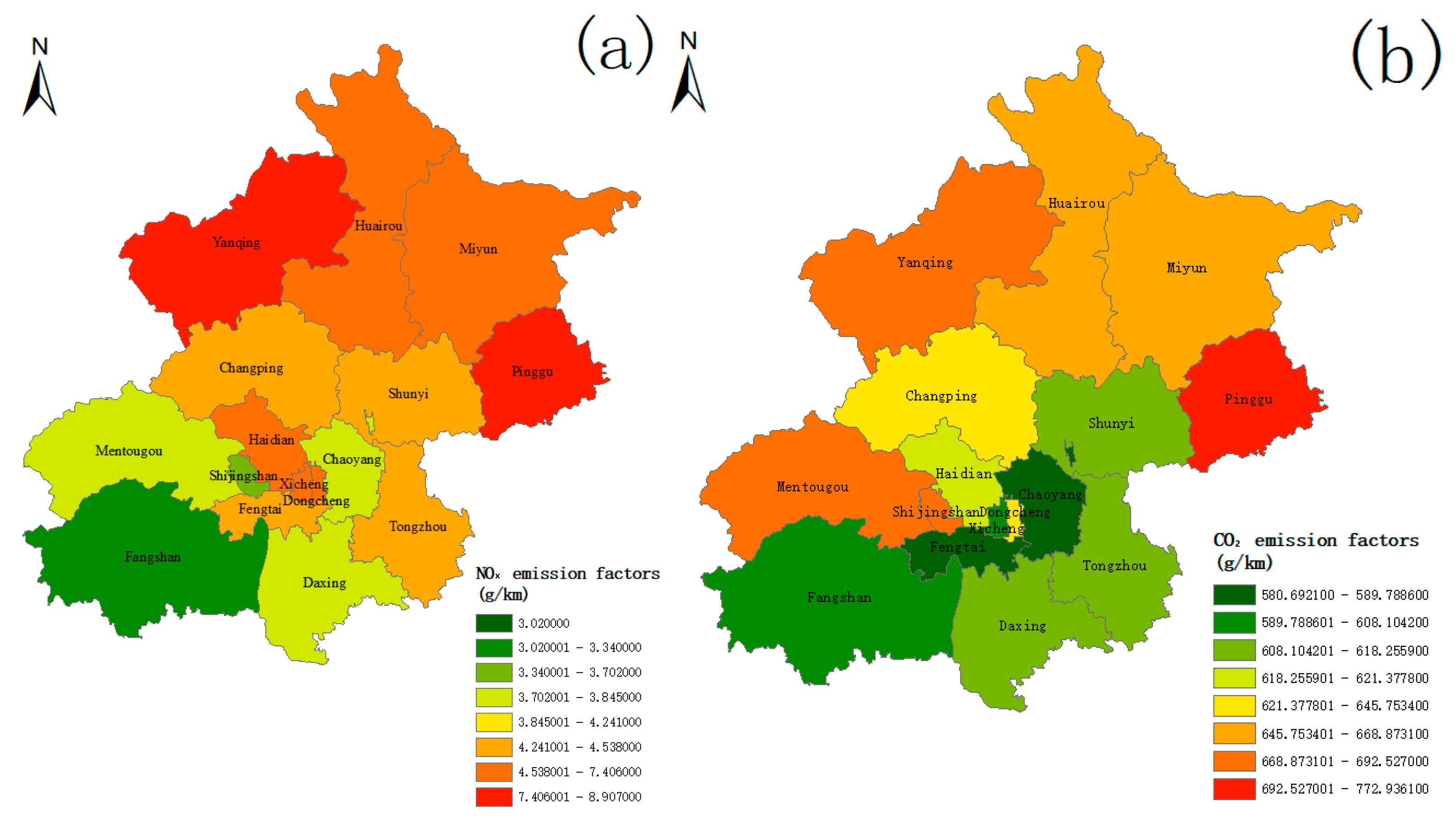Beijing Heavy-Duty Diesel Vehicle Battery Capacity Conversion and Emission Estimation in 2022
Abstract
:1. Introduction
2. Materials and Methods
2.1. Test the Equipment
2.2. Test Vehicle
2.3. Calculation Formula
2.3.1. NOx and CO2 Emission
2.3.2. Battery Capacities Conversion
2.3.3. Emission Estimates
3. Results
3.1. NOX and CO2 Annual Emissions
3.2. Activity Level
3.3. Electrification Emission Reduction Potential
3.3.1. Actual Fuel Consumption vs. Announced Fuel Consumption
3.3.2. Battery Capacities
3.3.3. Regional Emission Reductions
4. Conclusions
Author Contributions
Funding
Data Availability Statement
Conflicts of Interest
References
- Ministry of Ecology and Environment of the People’s Republic of China (MEE). China Mobile Source Environmental Management Annual Report. 2021. Available online: https://www.mee.gov.cn/hjzl/sthjzk/ydyhjgl/202109/W020210910400449015882 (accessed on 10 September 2021).
- Féral, J. IPCC, 2014: Climate Change 2014: Synthesis Report. Contribution of Working Groups I, II, and III to the Fifth Assessment Report of the Intergovernmental Panel on Climate Change. Environmental Science. 2015, 151. Available online: http://www.mendeley.com/research/climate-change-2014-synthesis-report-contribution-working-groups-i-ii-iii-fifth-assessment-report-in-20 (accessed on 20 March 2015).
- Degraeuwe, B.; Thunis, P.; Clappier, A.; Weiss, M.; Lefebvre, W.; Janssen, S.; Vranckx, S. Impact of passenger car NOx emissions and NO2 fractions on urban NO2 pollution—Scenario analysis for the city of Antwerp, Belgium. Atmos. Environ. 2015, 126, 218–224. [Google Scholar] [CrossRef]
- Tong, Z.; Chen, Y.; Malkawi, A.; Adamkiewicz, G.; Spengler, J. Quantifying the impact of traffic-related air pollution on the indoor air quality of a naturally ventilated building. Environ. Int. 2016, 89, 138–146. [Google Scholar] [CrossRef] [PubMed]
- Yuan, C.; Wu, D.; Liu, H. Using Grey Relational Analysis to Evaluate Energy Consumption, CO2 Emissions and Growth Patterns in China’s Provincial Transportation Sectors. Int. J. Environ. Res. Public Health 2017, 14, 1536. [Google Scholar] [CrossRef] [PubMed] [Green Version]
- Kazancoglu, Y.; Ozbiltekin-Pala, M.; Ozkan-Ozen, Y. Prediction and evaluation of greenhouse gas emissions for sustainable road transport within Europe. Sustain. Cities Soc. 2021, 70, 102924. [Google Scholar] [CrossRef]
- Huang, X.; Zhang, H.; Zhang, X. Decarbonising electricity systems in major cities through renewable cooperation—A case study of Beijing and Zhangjiakou. Energy 2020, 190, 116444. [Google Scholar] [CrossRef]
- Ai, Y.; Ge, Y.; Ran, Z.; Li, X.; Xu, Z.; Chen, Y.; Miao, X.; Xu, X.; Mao, H.; Shi, Z.; et al. Quantifying Air Pollutant Emission from Agricultural Machinery Using Surveys—A Case Study in Anhui, China. Atmosphere 2021, 12, 440. [Google Scholar] [CrossRef]
- Li, X.; Yang, L.; Liu, Y.; Zhang, C.; Xu, X.; Mao, H.; Jin, T. Emissions of air pollutants from non-road construction machinery in Beijing from 2015 to 2019. Environ. Pollut. 2023, 317, 120729. [Google Scholar] [CrossRef]
- Han, B.; Wang, L.; Deng, Z.; Shi, Y.; Yu, J. Source emission and attribution of a large airport in Central China. Sci. Total Environ. 2022, 829, 154519. [Google Scholar] [CrossRef]
- Wu, Y.; Zhang, S.; Li, M.; Ge, Y.; Shu, J.; Zhou, Y.; Xu, Y.; Hu, J.; Liu, H.; Fu, L.; et al. The challenge to NOx emission control for heavy-duty diesel vehicles in China. Atmos. Chem. Phys. 2012, 12, 9365–9379. [Google Scholar] [CrossRef] [Green Version]
- Sato, S.; Jiang, Y.; Russell, R.; Miller, J.; Karavalakis, G.; Durbin, T.; Johnson, K. Experimental driving performance evaluation of battery-powered medium and heavy duty all-electric vehicles. Int. J. Electr. Power Energy Syst. 2022, 141, 108100. [Google Scholar] [CrossRef]
- International Council on Clean Transportation (ICCT). Europe’s New Heavy-Duty CO2 Standards, Explained. 2023. Available online: https://theicct.org/eu-co2-hdv-standards-explained-feb23/ (accessed on 14 February 2023).
- Yang, Z.; Tate, J.; Morganti, E.; Philips, L.; Shepherd, S. How accelerating the electrification of the van sector in Great Britain can deliver faster CO2 and NOx reductions. Sustain. Cities Soc. 2023, 88, 104300. [Google Scholar] [CrossRef]
- California Environmental Protection Agency (CEPA). Governor Newsom’s Zero-Emission by 2035 Executive Order (N-79-20). 2021. Available online: https://ww2.arb.ca.gov/resources/fact-sheets/governor-newsoms-zero-emission-2035-executive-order-n-79-20 (accessed on 19 January 2021).
- Zhang, L.; Leng, K.; Li, S.; Wang, J. Comparative analysis of comprehensive benefits of Beijing?s taxi electrification paths. Transp. Res. Part D-Transp. Environ. 2023, 115, 103612. [Google Scholar] [CrossRef]
- Gao, Z.; LaClair, T.; Ou, S.; Huff, S.; Wu, G.; Hao, P.; Boriboonsomsin, K.; Barth, M. Evaluation of Electric Vehicle Component Performance over Eco-driving Cycles. Energy 2019, 172, 823–839. [Google Scholar] [CrossRef]
- Bucher, J.; Bradley, T.; Lohse-Busch, H.; Rask, E. Analyzing the Energy Consumption Variation during Chassis Dynamometer Testing of Conventional, Hybrid Electric, and Battery Electric Vehicles. SAE Int. J. Alt. Power. 2014, 3, 36–43. [Google Scholar] [CrossRef]
- Ma, X.; Miao, R.; Wu, X.; Liu, X. Examining influential factors on the energy consumption of electric and diesel buses: A data-driven analysis of large-scale public transit network in Beijing. Energy 2021, 216, 119196. [Google Scholar] [CrossRef]
- Xu, X.; Lv, X.; Han, L. Carbon Asset of Electrification: Valuing the Transition from Fossil Fuel-Powered Buses to Battery Electric Buses in Beijing. Sustainability 2019, 11, 2749. [Google Scholar] [CrossRef] [Green Version]
- Gunawan, T.; Monaghan, R. Techno-econo-environmental comparisons of zero- and low-emission heavy-duty trucks. Appl. Energy 2022, 308, 118327. [Google Scholar] [CrossRef]
- Liu, F.; Mauzerall, D.; Zhao, F.; Hao, H. Deployment of fuel cell vehicles in China: Greenhouse gas emission reductions from converting the heavy-duty truck fleet from diesel and natural gas to hydrogen. Int. J. Hydrog. Energy 2021, 46, 17982–17997. [Google Scholar] [CrossRef]
- Ministry of Ecology and Environment of the People’s Republic of China (MEE). DB11/1475-2017 Limits and Measurement Method of Emissions from Heavy-Duty Vehicle (OBD Method Phase IV and V). 2017. Available online: https://dbba.sacinfo.org.cn/stdDetail/497c753d2357ff8429a2fbec5b7a6381acf28d61e10593f816dad9feeefed5f2 (accessed on 1 December 2017).
- Durbin, T.; Jiang, Y.; Carlock, M.; Ventura, L.; Clark, N.; Mckain, D. Heavy-duty On-road Vehicle Inspection and Maintenance Program (Final Report). California Air Resources Board 2019, vi–vii. Available online: https://www.cert.ucr.edu/media/1251/download?attachment (accessed on 21 January 2019).
- Feng, Q.; Liu, B.; Yang, Y.; Zhang, S.; Shen, X.; Lu, Y.; Wang, P.; Wu, Y. Characteristics of actual road NOX and CO2 emissions from diesel vehicles in Beijing based on remote monitoring. China Environ. Sci. 2023. (In Chinese) [Google Scholar] [CrossRef]
- Huang, J.; Opoku, P.; Li, J.; Norgbey, E.; Brown, E. Two-Staged Dielectric Barrier Discharge-Urea Configuration for the Removal of NO of NOx in a Simulated Coal-Combustion Flue Gas. Water Air Soil Pollut 2019, 230, 120. [Google Scholar]
- Ministry of Ecology and Environment of the People’s Republic of China (MEE). Technical Guidance for the Preparation of Road Motor Vehicle Emission Inventories. 2014. Available online: https://www.mee.gov.cn/gkml/hbb/bgth/201407/W020140708387895271474 (accessed on 8 July 2014).
- Ministry of Ecology and Environment of the People’s Republic of China (MEE). China Mobile Source Environmental Management Annual Report. 2022. Available online: https://www.mee.gov.cn/hjzl/sthjzk/ydyhjgl/202212/W020221207387013521948 (accessed on 7 December 2022).
- International Energy Agency (IEA). CO2 Emissions in 2022. 2023. Available online: https://www.iea.org/reports/co2-emissions-in-2022 (accessed on 3 March 2023).
- Teixeira, A.; Sodré, J. Impacts of replacement of engine powered vehicles by electric vehicles on energy consumption and CO2 emissions. Transp. Res. Part D Transp. Environ. 2018, 59, 375–384. [Google Scholar] [CrossRef]
- Liimatainen, H.; Vliet, O.; Aplyn, D. The potential of electric trucks—An international commodity-level analysis. Appl. Energy 2019, 236, 804–814. [Google Scholar] [CrossRef]
- Zhang, X.; Nie, S.; He, M.; Wang, J. Charging system analysis, energy consumption, and carbon dioxide emissions of battery electric buses in Beijing. Case Stud. Therm. Eng. 2021, 26, 101197. [Google Scholar] [CrossRef]
- China EV100 Forum. CATARC Li Mengliang: The Cause, Research Process and Results of “China’s Working Conditions”. 2018. Available online: http://pba.cbea.com/zt1/201801/651029.html (accessed on 21 January 2018).
- Link, S.; Plötz, P. Technical Feasibility of Heavy-Duty Battery-Electric Trucks for Urban and Regional Delivery in Germany—A Real-World Case Study. World Electr. Veh. J. 2022, 13, 161. [Google Scholar]
- Patil, P.; Kazemzadeh, K.; Bansal, P. Integration of charging behavior into infrastructure planning and management of electric vehicles: A systematic review and framework. Sustain. Cities Soc. 2023, 88, 104265. [Google Scholar] [CrossRef]
- Zhou, Y.; Yu, Y.; Wang, Y.; He, B.; Yang, L. Mode substitution and carbon emission impacts of electric bike sharing systems. Sustain. Cities Soc. 2023, 89, 104312. [Google Scholar] [CrossRef]






| Parameter | Unit | Data Frequency (Hz) | Accuracy (%) |
|---|---|---|---|
| Air intake | kg/h | 1 | - 2 |
| Fuel flow | L/h | 1 | ±5 |
| SCR 1 downstream NOx transmitter output value | ppm | 1 | ±5 |
| Engine net output torque | % | 1 | ±3 |
| Frictional torque | % | 1 | ±3 |
| Engine speed | rpm | 1 | ±1 |
| Mileage accrual | km | 1 | - |
| Longitude | ° | 1 | 1 |
| Latitude | ° | 1 | 1 |
| Type of Industry | Number of Test Vehicles | Average Daily Fuel Consumption Factor (g/kWh) | Annual Mileage (km) | NOx Emission Factor (g/km) | CO2 Emission Factor (g/km) | Population | |
|---|---|---|---|---|---|---|---|
| National-V | National-VI | ||||||
| Engineering work vehicle | 49 | 303 | 352 | 22,313.6 | 3.5 | 420.9 | 7986 |
| Public transporter | 375 | 129 | 281 | 39,144.0 | 7.3 | 686.7 | 16,642 |
| Concrete truck | 129 | 191 | 285 | 33,721.2 | 16.8 | 1463.1 | 7530 |
| Freight truck | 1501 | 3658 | 227 | 57,736.6 | 3.1 | 549.5 | 114,266 |
| Airport bus | 15 | 1 | 226 | 7170.4 | 3.3 | 578.4 | 216 |
| Passenger bus | 253 | 74 | 226 | 41,814.6 | 2.9 | 616.3 | 6096 |
| Garbage truck | 23 | 160 | 253 | 29,320.8 | 3.9 | 675.9 | 4113 |
| Refrigerated truck | 191 | 752 | 222 | 85,205.2 | 4.1 | 515.4 | 20,854 |
| Tourist bus | 27 | 14 | 226 | 15,111.2 | 2.3 | 750.2 | 567 |
| Dangerous goods transporter | 36 | 41 | 224 | 73,179.9 | 6.2 | 685.1 | 1846 |
| School bus | 2 | 22 | 281 | 7703.7 | 0.9 | 533.3 | 331 |
| Postal truck | 29 | 33 | 219 | 53,300.5 | 5.0 | 553.8 | 1641 |
| Muck truck | 439 | 743 | 300 | 37,658.4 | 3.1 | 812.5 | 26,488 |
| Type of Industry | Changping | Chaoyang | Daxing | Dongcheng | Fangshan | Fengtai | Haidian | Huairou | Mentougou | Miyun | Pinggu | Shijingshan | Shunyi | Tongzhou | Xicheng | Yanqing |
|---|---|---|---|---|---|---|---|---|---|---|---|---|---|---|---|---|
| Engineering work vehicle | 4.7 | 4.1 | 2.4 | 4.6 | 1.8 | 3.6 | 3.8 | 2.3 | 2.3 | 4.7 | 3.7 | 3.3 | 3.8 | 4.0 | 4.0 | 2.0 |
| Public transporter | 6.6 | 7.9 | 7.4 | 7.5 | 5.7 | 8.5 | 7.1 | 7.5 | 7.8 | 5.8 | 9.4 | 8.5 | 9.2 | 7.2 | 6.3 | 4.3 |
| Concrete truck | 19.5 | 14.0 | 11.4 | 18.5 | 11.2 | 23.5 | 20.2 | 16.9 | 15.4 | 9.5 | 25.8 | 10.4 | 13.1 | 15.2 | 22.4 | 23.4 |
| Freight truck | 3.4 | 2.7 | 2.4 | 2.5 | 2.4 | 2.7 | 2.7 | 3.6 | 2.6 | 4.0 | 4.3 | 2.6 | 3.7 | 2.7 | 2.7 | 3.9 |
| Airport bus | 2.2 | 2.9 | 2.1 | 5.1 | 3.0 | 3.1 | 2.5 | - | - | - | 4.9 | - | 4.5 | 5.2 | 3.0 | - |
| Passenger bus | 1.7 | 1.8 | 2.1 | 3.5 | 2.3 | 3.6 | 2.7 | 4.4 | 2.1 | 1.9 | 11.6 | 1.8 | 3.0 | 2.2 | 2.2 | 5.5 |
| Garbage truck | 3.9 | 3.5 | 3.9 | 5.7 | 2.2 | 6.5 | 3.9 | 2.4 | 5.1 | 2.1 | 2.8 | 2.3 | 2.3 | 7.3 | 2.7 | 5.2 |
| Refrigerated truck | 3.9 | 3.2 | 3.0 | 6.4 | 2.6 | 4.7 | 3.7 | 2.7 | 2.1 | 2.4 | 6.1 | 3.5 | 3.6 | 3.9 | 6.4 | 8.6 |
| Tourist bus | 2.7 | 1.9 | 2.2 | 1.7 | 2.0 | 2.2 | 2.2 | 2.8 | 1.9 | 3.9 | 3.3 | 2.0 | 1.6 | 2.1 | 2.1 | 5.6 |
| Dangerous goods transporter | 6.4 | 5.9 | 4.8 | 3.5 | 5.0 | 6.1 | 8.3 | 4.4 | 5.6 | 12.3 | 8.6 | 4.6 | 5.4 | 4.5 | 6.5 | 11.8 |
| School bus | 1.4 | 0.7 | 1.1 | 0.9 | 0.8 | 0.6 | 1.1 | - | 0.9 | - | - | 0.6 | 0.5 | 1.1 | 1.1 | - |
| Postal truck | 3.5 | 3.2 | 3.8 | 6.1 | 1.1 | 4.2 | 8.8 | 0.3 | 2.1 | 1.0 | 2.2 | 0.8 | 13.0 | 9.3 | 7.3 | 7.2 |
| Muck truck | 2.8 | 2.2 | 3.4 | 3.5 | 3.6 | 2.8 | 2.0 | 3.3 | 2.6 | 4.9 | 4.1 | 2.7 | 3.5 | 2.5 | 2.5 | 3.5 |
| Type of Industry | Changping | Chaoyang | Daxing | Dongcheng | Fangshan | Fengtai | Haidian | Huairou | Mentougou | Miyun | Pinggu | Shijingshan | Shunyi | Tongzhou | Xicheng | Yanqing |
|---|---|---|---|---|---|---|---|---|---|---|---|---|---|---|---|---|
| Engineering work vehicle | 411.6 | 385.0 | 403.8 | 343.2 | 389.8 | 353.5 | 402.0 | 538.2 | 432.4 | 507.5 | 532.2 | 387.4 | 441.5 | 380.4 | 369.8 | 470.2 |
| Public transporter | 660.3 | 667.4 | 624.4 | 748.2 | 644.1 | 687.9 | 643.5 | 667.2 | 665.5 | 1211.7 | 1204.8 | 593.2 | 738.9 | 641.8 | 687.2 | 689.4 |
| Concrete truck | 1494.4 | 1394.7 | 1420.7 | 1615.4 | 1517.8 | 1397.5 | 1489.2 | 1506.1 | 1610.7 | 1292.0 | 1431.8 | 1467.6 | 1382.1 | 1400.2 | 1379.5 | 1608.6 |
| Freight truck | 555.1 | 550.6 | 528.8 | 515.7 | 534.7 | 529.5 | 526.2 | 581.9 | 590.6 | 553.2 | 565.9 | 539.6 | 561.1 | 544.9 | 530.4 | 582.8 |
| Airport bus | 707.6 | 651.7 | 479.3 | 637.6 | 464.4 | 493.6 | 492.4 | - | - | - | - | - | 734.9 | 762.9 | 626.4 | - |
| Passenger bus | 605.0 | 538.1 | 572.9 | 571.9 | 604.8 | 555.5 | 575.0 | 695.2 | 699.5 | 630.8 | 1212.4 | 616.4 | 685.1 | 579.0 | 609.0 | 582.2 |
| Garbage truck | 812.0 | 710.5 | 836.7 | 574.0 | 568.8 | 554.9 | 544.3 | 752.0 | 888.8 | 490.2 | 582.5 | 667.9 | 668.4 | 814.0 | 598.7 | 597.6 |
| Refrigerated truck | 497.6 | 496.1 | 504.4 | 535.1 | 504.6 | 498.0 | 481.9 | 537.6 | 512.3 | 537.2 | 554.3 | 459.4 | 509.4 | 524.2 | 499.9 | 644.3 |
| Tourist bus | 781.6 | 726.4 | 771.7 | 687.1 | 707.1 | 702.7 | 701.5 | 804.5 | 661.3 | 943.8 | 867.5 | 717.5 | 768.5 | 819.0 | 746.9 | 783.8 |
| Dangerous goods transporter | 678.5 | 676.7 | 611.5 | 727.1 | 643.3 | 645.5 | 643.9 | 624.7 | 661.7 | 843.1 | 1099.0 | 606.9 | 702.0 | 679.9 | 600.0 | 637.6 |
| School bus | 541.8 | 540.0 | 490.2 | 559.8 | 525.8 | 534.1 | 578.6 | - | 473.2 | - | - | 481.5 | 633.6 | 523.5 | 488.2 | - |
| Postal truck | 540.8 | 494.1 | 489.4 | 555.1 | 532.4 | 472.3 | 660.1 | 420.8 | 424.9 | 583.0 | 680.8 | 388.4 | 854.6 | 609.1 | 613.5 | 957.7 |
| Muck truck | 917.5 | 747.1 | 879.9 | 745.5 | 866.2 | 841.0 | 842.0 | 807.9 | 782.5 | 943.4 | 726.5 | 806.0 | 777.9 | 799.5 | 732.0 | 739.7 |
Disclaimer/Publisher’s Note: The statements, opinions and data contained in all publications are solely those of the individual author(s) and contributor(s) and not of MDPI and/or the editor(s). MDPI and/or the editor(s) disclaim responsibility for any injury to people or property resulting from any ideas, methods, instructions or products referred to in the content. |
© 2023 by the authors. Licensee MDPI, Basel, Switzerland. This article is an open access article distributed under the terms and conditions of the Creative Commons Attribution (CC BY) license (https://creativecommons.org/licenses/by/4.0/).
Share and Cite
Fu, M.; Yang, Y.; Li, Y.; Wang, H.; Yu, F.; Liu, J. Beijing Heavy-Duty Diesel Vehicle Battery Capacity Conversion and Emission Estimation in 2022. Sustainability 2023, 15, 11019. https://doi.org/10.3390/su151411019
Fu M, Yang Y, Li Y, Wang H, Yu F, Liu J. Beijing Heavy-Duty Diesel Vehicle Battery Capacity Conversion and Emission Estimation in 2022. Sustainability. 2023; 15(14):11019. https://doi.org/10.3390/su151411019
Chicago/Turabian StyleFu, Mengqi, Yanyan Yang, Yong Li, Huanqin Wang, Fajun Yu, and Juan Liu. 2023. "Beijing Heavy-Duty Diesel Vehicle Battery Capacity Conversion and Emission Estimation in 2022" Sustainability 15, no. 14: 11019. https://doi.org/10.3390/su151411019






